Friends on the Shelf: real life stories
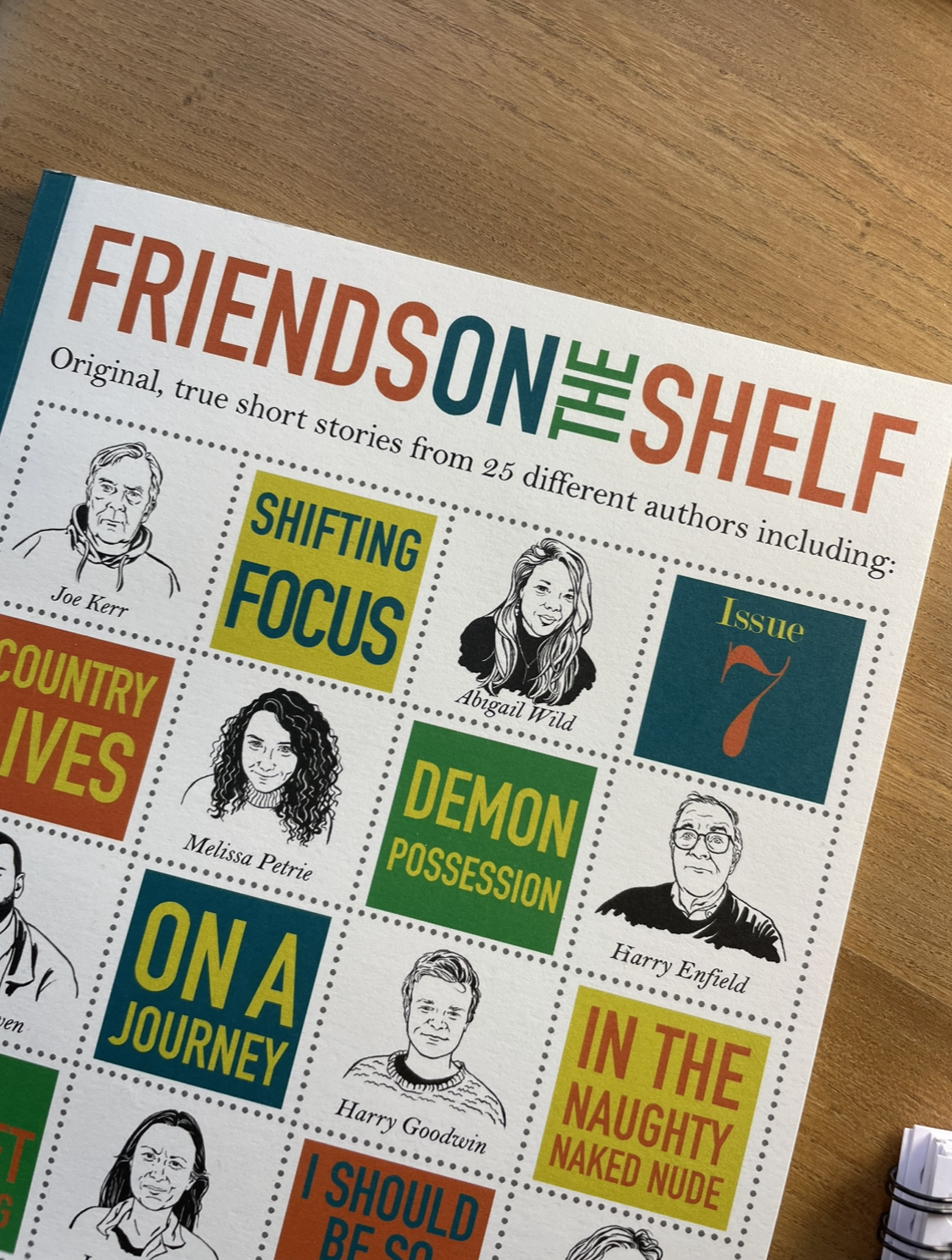
Have you heard about Friends on the Shelf? This beautifully designed independent magazine features real life stories from known and unknown writers.
At the beginning of the latest issue, you have Harry Enfield writing about adopting a duckling; later on, you have me describing my brief foray into the world of naturism.
Some stories are very much of the moment, such as ‘The Story of my Life’ in issue 7, where Svitlana Lychkovska writes about living in Kyiv as Russian rockets fly over her house. Others recount old memories, as when Nicole Hood recalls the strange experience of having a doppelganger during her time at Camberwell School of Art in issue 5.
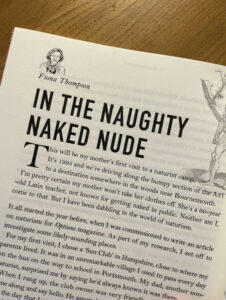
My advice? Don’t Google ‘naughty naked nude’ if you’re looking for Ian Dury lyrics
A few of my favourite things
Here are a few stories that have stayed with me from the seven issues of the magazine so far.
The Stupid Button in issue 1. First up, the title is genius. You just have to read that story. Alice-Mae Mayall describes her time as a teacher when she accidentally leant against the ‘stupid button’ in class and cut off all the power. All her students lost their graphics and she swiftly reframed her mistake as a lesson to always back up your work as you’re going along.
Next, the bus driver. Joe Kerr writes about his experience of driving a single decker bus in north London. One day, a lady banged on the plastic partition and announced, “There’s your lunch, driver,” handing him a white paper bag containing a packet of plain crisps, a Kit Kat and a Bounty. He writes poignantly about the impact of this stranger who regularly offered him the same lunch, then suddenly disappeared. He never discovered her name or why she gave him these daily offerings.
In issue 7, I loved The Foxglove. Lotie Parker writes about finding gardening therapeutic after the death of her mother. She describes seeing a foxglove appear in her garden and immediately knowing that it’s a reincarnation of her mother. It’s a startling, funny idea that is also totally believable. Who knows how any of us may be reincarnated? Haunting a flowerbed seems entirely reasonable to me.
How the magazine sprang into life
Recently, I caught up with Rachel Swann, editor of Friends on the Shelf, to investigate why she and her old friend, Vick Fullick, decided to launch the magazine, how it’s going and their plans for the future.
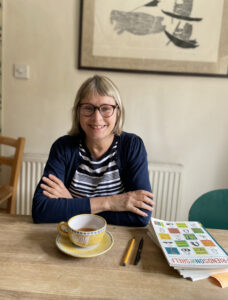
Rachel Swann, who founded Friends on the Shelf with her friend, Vick Fullick
Given the tough climate for magazine publishers, it was a punchy move to launch a new magazine. What inspired them to do it?
“Vick and I had been talking for a while about finding a project we could work on together,” says Rachel. “We wanted to do something that combined both our skills. Vick’s a brilliant designer and I have a background as a TV comedy writers’ agent and wanted to do something book-ish or magazine-ish.
“We looked at some magazines and thought the stories weren’t that interesting. We realised we got more entertainment out of talking to our friends and hearing their tales.”
The pair were also inspired by Jenna Bailey’s book, ‘Can any mother help me?’, which narrates the story of The Cooperative Correspondence Club, letters written by women to each other between 1930 to 1970. “It was like a secret magazine,” says Rachel. “The women wrote movingly and often very entertainingly about their lives. They used pseudonyms so they could be really honest.”
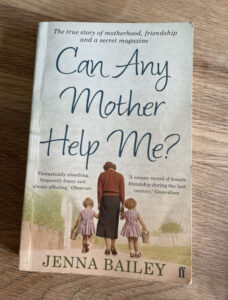
Rachel and Vick were inspired by this book where women exchanged information anonymously
Stories without an agenda
Rachel and Vick liked the idea of producing a creative literary magazine that’s chatty and easy to read.
Rachel says: “Fiona Hamilton at Pics and Ink, the online newsstand for independent magazines, said she loves that our writers don’t have an agenda. They’re not trying to make a point or plug something. They’re just telling a story. I think that creates a feeling of warmth and connection with readers.”
As for the style of the stories you’re likely to find between the covers: “They’re true stories written in the first person that have never been published before. They can be funny or sad, but they all offer a glimpse into someone’s life.”
Stories can be about something apparently small and simple, but they also evoke meaning and feeling. Rachel gives the example of Dreda Say Mitchell’s story, ‘The Hammock’, which appears in issue 2.
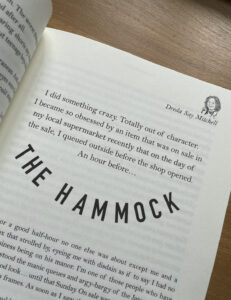
Dreda Say Mitchell is inexplicably drawn towards a hammock
“Dreda describes finding herself queuing to buy a hammock at a local supermarket, and can’t quite understand why she’s doing it. Then, as she relaxes while swinging in the hammock, she realises that a bit of cloth attached to a metal frame has finally allowed her to step off the treadmill of an overly-busy life. Having grown up on a housing estate in the East End, the daughter of immigrants from Grenada, it felt like the first time she’d rewarded herself for working less hard.
“The story starts small, but goes to the heart of who she is and where she’s come from.”
Eye-catching design
The design of the magazines is extremely thoughtful, thanks to the expertise of Vick Fullick. It features marbled end papers, clear, beautiful typefaces, pen portraits and illustrations that echo the stories. I’m thinking of the bee that carries a suitcase to accompany Phoenix Tran’s story ‘From A to Bee’ in issue 5.
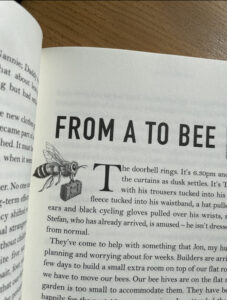
Phoenix Tran’s bees are going on holiday
Each issue also features entertaining graphic stories for a change of pace.
Vick describes the choice of paper stock for the magazine. She says: “Inspired by magazines such as Slightly Foxed and The Idler, we knew we wanted the paper to be a good quality off-white stock. We really pushed the printer on this and in the end, they gave us a special offer on the paper. For some reason, off-white paper is more expensive than white. The perfect binding was also inspired by the afore-mentioned magazines and adds to the ‘bookish’ feel.”
The pair also wanted the design to be clear and legible. Vick adds: “Typography design needs to be almost invisible if you want readers to enjoy the story without being distracted by overly-designed typography. The choice and size of typeface (Bell MT 12 point on 16 point leading), as well as the margins around the type were an important consideration.
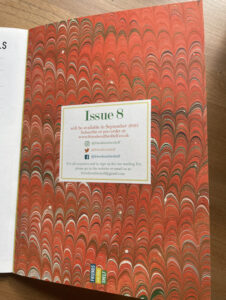
Designer Vick learned how to create marbled papers on a course
“The endpapers are all scanned, hand-marbled paper that I made a few years ago on a paper marbling course (apart from issue 6 which is a Photoshop generated pattern). The illustrations are largely there to lighten the mood of the page and give each story its own personality.
“An old friend from school, who is an illustrator, agreed to do the pen portraits of each author. Rachel and I gave authors the choice of using a pseudonym, if they didn’t want to put their own name to the story but we felt it was important that readers knew that these stories were written by real people. So instead of having a photograph of each one at the top of their article, we gave them an added layer of anonymity by having a drawing of them instead.
“Because the text pages are black and white only, we decided to have a nice colourful, eye-catching cover which places the emphasis on the people who have written, with some of the pen portraits. Each issue has a different colour palette. The back cover graphically represents books on shelves with the names of all the contributors – from writers and illustrators to helpers – on the spines.”
Emerging in the pandemic
By chance, the first magazine came out during the pandemic. This helped to establish a readership, as people were able to feel a sense of companionship by reading stories in the magazine, while many were stuck at home.
Rachel and Vick put the first magazine together on their own, but have since built up a small gang of editorial helpers who regularly lend a hand with editing, proof reading and marketing. “I had no idea how much work it would be to keep on top of the marketing, subscriptions and admin,” says Rachel. “Thank goodness we have friends who volunteered to help.”
The team has gained in confidence since the first issue. They’re also now receiving submissions from as far away as New Zealand and Australia.

I carried this crumpled flyer around for quite some time
Extraordinary true stories
“At the start, I thought we’d mostly receive light, funny stories like ‘The Stupid Button’,” says Rachel. “But people have sent in the most extraordinary stories.
“In issue 5, our computer guy, Pablo Griffiths, wrote ‘He was a quiet man’, about the shock of discovering that his loving grandfather had fought for the Fascists and killed people in the Spanish Civil War.
“Lili Caseley wrote in issue 4 about being caught up in the London Bridge attacks in 2017. A terrorist burst into the pub where she was celebrating her 21st birthday and she had to hide out in the toilets.
“In the same issue, Neil Philip wrote about the terrifying experience of witnessing the 2004 Boxing Day tsunami from a beach in Thailand.”
Stories laid out like album tracks
“We like that we attract all kinds of stories,” adds Rachel. “We have some that are funny, and some that are much more serious. When laying out the magazine, I put them in an order that makes sense one by one, like listening to an album. You don’t want too many exciting ones together. We hope that readers never know what kind of story they’re going to read next.”
Famous friends
You’ll also notice a number of well-known names scattered among the pages of Friends on the Shelf, from Charlie Higson, Chris Difford and Jean-Paul Flintoff to Peter Curran and Harry Enfield.
How did this happen?
“We’ve been lucky to include a number of well-known people on our pages and this is simply due to the fact that we know them, and asked them directly to write for us,” says Rachel. “I used to be Harry Enfield’s agent, who was a school friend of my husband David Cummings, who was at UEA with Paul Whitehouse and Charlie Higson, who happens to be married to Vick! One of my oldest friends, musician Kate St. John introduced Chris Difford to Friends On The Shelf. Charlie Higson was on a quiz team with Peter Curran so introduced him to Friends on the Shelf too – and so it goes. For some of these writers, it has given them the opportunity to share a personal story that may not have found an audience elsewhere.”
The future for Friends on the Shelf
Friends on the Shelf is now available in an ever-growing list of places, from Mag Culture and Magma in London to the Arnolfini in Bristol, Rare Mags in Stockport and Golden Hare Books in Edinburgh.
Rachel and Vick have already put on a few very successful readings in London and hope to do more. “Reading the stories in an intimate setting like someone’s front room or a book shop brings a new dimension, which is really exciting,” says Rachel.
“We’re very unlikely media moguls, me and Vick. We do it because we love it and it’s fun. And why not?”
More
- To read my story, buy issue 7 of Friends on the Shelf
- Hire me for one-to-one writing coaching
- Read about my work with music clients